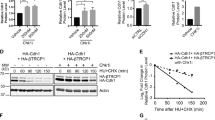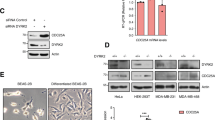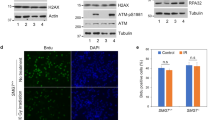Abstract
The tumour suppressor HIPK2 is an important regulator of cell death induced by DNA damage, but how its activity is regulated remains largely unclear. Here we demonstrate that HIPK2 is an unstable protein that colocalizes and interacts with the E3 ubiquitin ligase Siah-1 in unstressed cells. Siah-1 knockdown increases HIPK2 stability and steady-state levels, whereas Siah-1 expression facilitates HIPK2 polyubiquitination, degradation and thereby inactivation. During recovery from sublethal DNA damage, HIPK2, which is stabilized on DNA damage, is degraded through a Siah-1-dependent, p53-controlled pathway. Downregulation of Siah-1 inhibits HIPK2 degradation and recovery from damage, driving the cells into apoptosis. We have also demonstrated that DNA damage triggers disruption of the HIPK2–Siah-1 complex, resulting in HIPK2 stabilization and activation. Disruption of the HIPK2–Siah-1 complex is mediated by the ATM/ATR pathway and involves ATM/ATR-dependent phosphorylation of Siah-1 at Ser 19. Our results provide a molecular framework for HIPK2 regulation in unstressed and damaged cells.
This is a preview of subscription content, access via your institution
Access options
Subscribe to this journal
Receive 12 print issues and online access
$209.00 per year
only $17.42 per issue
Buy this article
- Purchase on Springer Link
- Instant access to full article PDF
Prices may be subject to local taxes which are calculated during checkout








Similar content being viewed by others
References
Rouse, J. & Jackson, S. P. Interfaces between the detection, signaling, and repair of DNA damage. Science 297, 547–551 (2002).
Zhou, B. B. & Elledge, S. J. The DNA damage response: putting checkpoints in perspective. Nature 408, 433–439 (2000).
Shiloh, Y. ATM and related protein kinases: safeguarding genome integrity. Nature Rev. Cancer 3, 155–168 (2003).
Kastan, M. B. & Lim, D. S. The many substrates and functions of ATM. Nature Rev. Mol. Cell Biol. 1, 179–186 (2000).
Abraham, R. T. Cell cycle checkpoint signaling through the ATM and ATR kinases. Genes Dev. 15, 2177–2196 (2001).
Kim, Y. H., Choi, C. Y., Lee, S. J., Conti, M. A. & Kim, Y. Homeodomain-interacting protein kinases, a novel family of co-repressors for homeodomain transcription factors. J. Biol. Chem. 273, 25875–25879 (1998).
Hofmann, T. G. et al. Regulation of p53 activity by its interaction with homeodomain-interacting protein kinase-2. Nature Cell Biol. 4, 1–10 (2002).
D'Orazi, G. et al. Homeodomain-interacting protein kinase-2 phosphorylates p53 at Ser 46 and mediates apoptosis. Nature Cell Biol. 4, 11–19 (2002).
Zhang, Q., Yoshimatsu, Y., Hildebrand, J., Frisch, S. M. & Goodman, R. H. Homeodomain interacting protein kinase 2 promotes apoptosis by downregulating the transcriptional co-repressor CtBP. Cell 115, 177–186. (2003).
Pierantoni, G. M. et al. The homeodomain-interacting protein kinase 2 gene is expressed late in embryogenesis and preferentially in retina, muscle, and neural tissues. Biochem. Biophys. Res. Commun. 290, 942–947. (2002).
Pierantoni, G. M. et al. High-mobility group A1 inhibits p53 by cytoplasmic relocalization of its proapoptotic activator HIPK2. J. Clin. Invest. 117, 693–702 (2007).
Wei, G. et al. HIPK2 represses β-catenin-mediated transcription, epidermal stem cell expansion, and skin tumorigenesis. Proc. Natl Acad. Sci. USA 104, 13040–13045 (2007).
Li, X. L. et al. Mutations of the HIPK2 gene in acute myeloid leukemia and myelodysplastic syndrome impair AML1- and p53-mediated transcription. Oncogene 26, 7231–7239 (2007).
Oda, K. et al. p53AIP1, a potential mediator of p53-dependent apoptosis, and its regulation by Ser-46-phosphorylated p53. Cell 102, 849–862 (2000).
Hofmann, T. G. & Will, H. Body language: the function of PML nuclear bodies in apoptosis regulation. Cell Death Differ. 10, 1290–1299 (2003).
Moller, A. et al. PML is required for homeodomain-interacting protein kinase 2 (HIPK2)-mediated p53 phosphorylation and cell cycle arrest but is dispensable for the formation of HIPK domains. Cancer Res. 63, 4310–4314. (2003).
Rui, Y. et al. Axin stimulates p53 functions by activation of HIPK2 kinase through multimeric complex formation. EMBO J. 23, 4583–4594 (2004).
Gresko, E. et al. Autoregulatory control of the p53 response by caspase-mediated processing of HIPK2. EMBO J. 25, 1883–1894 (2006).
Grooteclaes, M. et al. C-terminal-binding protein corepresses epithelial and proapoptotic gene expression programs. Proc. Natl Acad. Sci. USA 100, 4568–4573 (2003).
Di Stefano, V., Rinaldo, C., Sacchi, A., Soddu, S. & D'Orazi, G. Homeodomain-interacting protein kinase-2 activity and p53 phosphorylation are critical events for cisplatin-mediated apoptosis. Exp. Cell Res. 293, 311–320 (2004).
Dauth, I., Kruger, J. & Hofmann, T. G. Homeodomain-Interacting Protein Kinase 2 Is the Ionizing Radiation-Activated p53 Serine 46 Kinase and Is Regulated by ATM. Cancer Res. 67, 2274–2279 (2007).
Hofmann, T.G., Jaffray, E., Stollberg, N., Hay, R. T. & Will, H. Regulation of homeodomain-interacting protein kinase 2 (HIPK2) effector function through dynamic small ubiquitin-related modifier-1 (SUMO-1) modification. J. Biol. Chem. 280, 29224–29232 (2005).
Germani, A. et al. SIAH-1 interacts with α-tubulin and degrades the kinesin Kid by the proteasome pathway during mitosis. Oncogene 19, 5997–6006. (2000).
Reed, J. C. & Ely, K. R. Degrading liaisons: Siah structure revealed. Nature Struct. Biol. 9, 8–10. (2002).
Bruzzoni-Giovanelli, H. et al. SIAH-1 inhibits cell growth by altering the mitotic process. Oncogene 18, 7101–7109. (1999).
Fanelli, M. et al. The coiled-coil domain is the structural determinant for mammalian homologues of Drosophila Sina-mediated degradation of promyelocytic leukemia protein and other tripartite motif proteins by the proteasome. J. Biol. Chem. 279, 5374–5379 (2004).
Matsuzawa, S., Takayama, S., Froesch, B. A., Zapata, J. M. & Reed, J. C. p53-inducible human homologue of Drosophila seven in absentia (Siah) inhibits cell growth: suppression by BAG-1. EMBO J. 17, 2736–2747. (1998).
Matsuzawa, S. I. & Reed, J. C. Siah-1, SIP, and Ebi collaborate in a novel pathway for β-catenin degradation linked to p53 responses. Mol. Cell 7, 915–926. (2001).
Liu, J. et al. Siah-1 mediates a novel β-catenin degradation pathway linking p53 to the adenomatous polyposis coli protein. Mol. Cell 7, 927–936. (2001).
Rinaldo, C. et al. MDM2-regulated degradation of HIPK2 prevents p53Ser46 phosphorylation and DNA damage-induced apoptosis. Mol. Cell 25, 739–750 (2007).
de Oca Luna, R., Wagner, D. S. & Lozano, G. Rescue of early embryonic lethality in mdm2-deficient mice by deletion of p53. Nature 378, 203–206 (1995).
House, C. M. et al. A binding motif for Siah ubiquitin ligase. Proc. Natl Acad. Sci. USA 100, 3101–3106 (2003).
Gresko, E., Moller, A., Roscic, A. & Schmitz, M. L. Covalent modification of human homeodomain interacting protein kinase 2 by SUMO-1 at lysine 25 affects its stability. Biochem. Biophys. Res. Commun. 329, 1293–1299 (2005).
Polekhina, G. et al. Siah ubiquitin ligase is structurally related to TRAF and modulates TNF-α signaling. Nature Struct. Biol. 9, 68–75. (2002).
Okamura, S. et al. p53DINP1, a p53-inducible gene, regulates p53-dependent apoptosis. Mol. Cell 8, 85–94. (2001).
Brooks, C. L. & Gu, W. p53 ubiquitination: Mdm2 and beyond. Mol. Cell 21, 307–315 (2006).
Fiucci, G. et al. Siah-1b is a direct transcriptional target of p53: Identification of the functional p53 responsive element in the siah-1b promoter. Proc. Natl Acad. Sci. USA 101, 3510–3515 (2004).
Iwai, A. et al. Siah-1L, a novel transcript variant belonging to the human Siah family of proteins, regulates β-catenin activity in a p53-dependent manner. Oncogene 23, 7593–7600 (2004).
Oren, M. Decision making by p53: life, death and cancer. Cell Death Differ. 10, 431–442. (2003).
Stiff, T. et al. ATR-dependent phosphorylation and activation of ATM in response to UV treatment or replication fork stalling. EMBO J. 25, 5775–5782 (2006).
Hickson, I. et al. Identification and characterization of a novel and specific inhibitor of the ataxia-telangiectasia mutated kinase ATM. Cancer Res. 64, 9152–9159 (2004).
Shreeram, S. et al. Wip1 phosphatase modulates ATM-dependent signaling pathways. Mol. Cell 23, 757–764 (2006).
Lu, X., Nannenga, B. & Donehower, L. A. PPM1D dephosphorylates Chk1 and p53 and abrogates cell cycle checkpoints. Genes Dev. 19, 1162–1174 (2005).
Schmidt, R. L. et al. Inhibition of RAS-mediated transformation and tumorigenesis by targeting the downstream E3 ubiquitin ligase seven in absentia homologue. Cancer Res. 67, 11798–11810 (2007).
Hofmann, T. G., Stollberg, N., Schmitz, M. L. & Will, H. HIPK2 Regulates Transforming Growth Factor-β-induced c-jun NH(2)-terminal kinase activation and apoptosis in human hepatoma cells. Cancer Res. 63, 8271–8277 (2003).
Shiotani, B. et al. Involvement of the ATR- and ATM-dependent checkpoint responses in cell cycle arrest evoked by pierisin-1. Mol. Cancer Res. 4, 125–133 (2006).
Milovic-Holm, K., Krieghoff, E., Jensen, K., Will, H. & Hofmann, T. G. FLASH links the CD95 signaling pathway to the cell nucleus and nuclear bodies. EMBO J. 26, 391–401 (2007).
Hofmann, T. G., Hehner, S. P., Droge, W. & Schmitz, M. L. Caspase-dependent cleavage and inactivation of the Vav1 proto-oncogene product during apoptosis prevents IL-2 transcription. Oncogene 19, 1153–1163. (2000).
Cliby, W. A. et al. Overexpression of a kinase-inactive ATR protein causes sensitivity to DNA-damaging agents and defects in cell cycle checkpoints. EMBO J. 17, 159–169 (1998).
Canman, C. E. et al. Activation of the ATM kinase by ionizing radiation and phosphorylation of p53. Science 281, 1677–1679 (1998).
Acknowledgements
We are grateful to the following colleagues for providing expression plasmids, cell lines or antibodies: L. Susini, P. Matthias, G. Rohaly, T. Wirth, R. Marschalek, R.T. Abraham, M.B. Kastan, B. Vogelstein and G. Lozano. We thank E. Krieghoff-Henning for comments on the manuscript and B. Haas for technical assistance. This study was supported by grants from the Deutsche Krebshilfe (10-2211-Ho1), the Deutsche Forschungsgemeinschaft (HO2438/3-1) and the Landesstiftung Baden-Württemberg to T.G.H.
Author information
Authors and Affiliations
Corresponding author
Ethics declarations
Competing interests
The authors declare no competing financial interests.
Supplementary information
Supplementary Information
Supplementary Figures S1, S2, S3, S4, S5, S6, S7 (PDF 884 kb)
Rights and permissions
About this article
Cite this article
Winter, M., Sombroek, D., Dauth, I. et al. Control of HIPK2 stability by ubiquitin ligase Siah-1 and checkpoint kinases ATM and ATR. Nat Cell Biol 10, 812–824 (2008). https://doi.org/10.1038/ncb1743
Received:
Accepted:
Published:
Issue Date:
DOI: https://doi.org/10.1038/ncb1743
This article is cited by
-
SIAH2-mediated and organ-specific restriction of HO-1 expression by a dual mechanism
Scientific Reports (2020)
-
Crosstalk between NRF2 and HIPK2 shapes cytoprotective responses
Oncogene (2017)
-
p300-mediated acetylation increased the protein stability of HIPK2 and enhanced its tumor suppressor function
Scientific Reports (2017)
-
Homeodomain-Interacting Protein Kinase (HPK-1) regulates stress responses and ageing in C. elegans
Scientific Reports (2016)
-
CHK2 stability is regulated by the E3 ubiquitin ligase SIAH2
Oncogene (2016)



